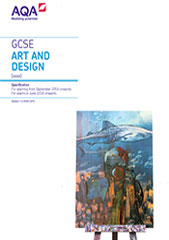3.6 Graphic communication
Graphic communication is defined here as the process of designing primarily visual material to convey information, ideas, meaning and emotions in response to a given or self-defined brief.
Areas of study
In Component 1 and Component 2 students are required to work in one or more area(s) of graphic communication, such as those listed below:
- communication graphics
- design for print
- advertising and branding
- illustration
- package design
- typography
- interactive design (including web, app and game)
- multi-media
- motion graphics
- signage
- exhibition graphics.
They may explore overlapping areas and combinations of areas.
Knowledge, understanding and skills
Students must develop and apply the knowledge, understanding and skills specified in the Subject content to realise personal intentions relevant to graphic communication and their selected area(s) of study.
The following aspects of knowledge, understanding and skills are defined in further detail to ensure students’ work is clearly focused and relevant to graphic communication.
Knowledge and understanding
The way sources inspire the development of ideas relevant to graphic communication including:
- how sources relate to a given or self-defined brief which might, for example, have a commercial, social or environmental focus or be concerned with other aspects specific to the creative industries
- how ideas, themes, forms, issues and needs can provide the stimulus for creative, imaginative, thoughtful and appropriately focused responses that are fit for a specific intended purpose.
The ways in which meanings, ideas and intentions relevant to graphic communication can be communicated include the use of:
- different forms of representation, brand identity, intended message, target audience and working within parameters determined by client and/or audience expectations and requirements
- visual and tactile elements, such as:
- colour
- line
- form
- tone
- texture
- shape
- pattern
- composition
- stylisation
- simplification
- scale
- structure.
Skills
Within the context of graphic communication, students must demonstrate the ability to:
- use graphic communication techniques and processes, appropriate to students’ personal
intentions, for example:
- typography
- illustration
- digital and/or non-digital photography
- hand rendered working methods
- digital working methods
- use media and materials, as appropriate to students’ personal intentions, for example:
- pencil, pen and ink, pen and wash, crayon, and other graphic media
- watercolour, gouache and acrylic paint
- layout materials
- digital media
- printmaking
- mixed media.
